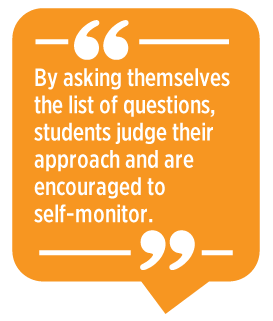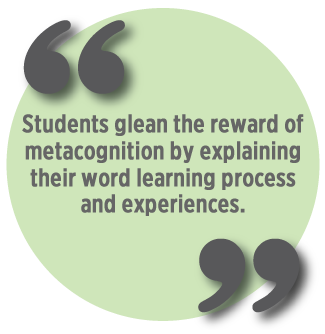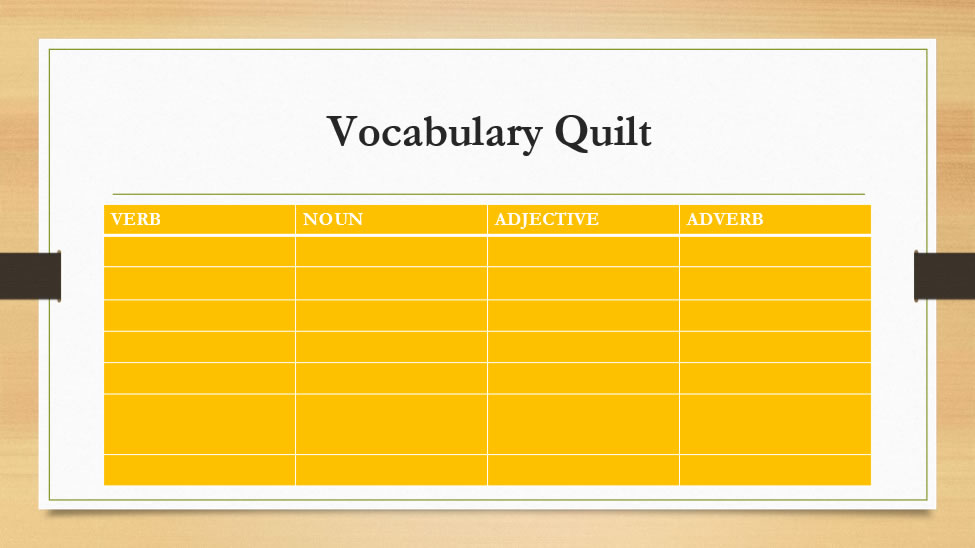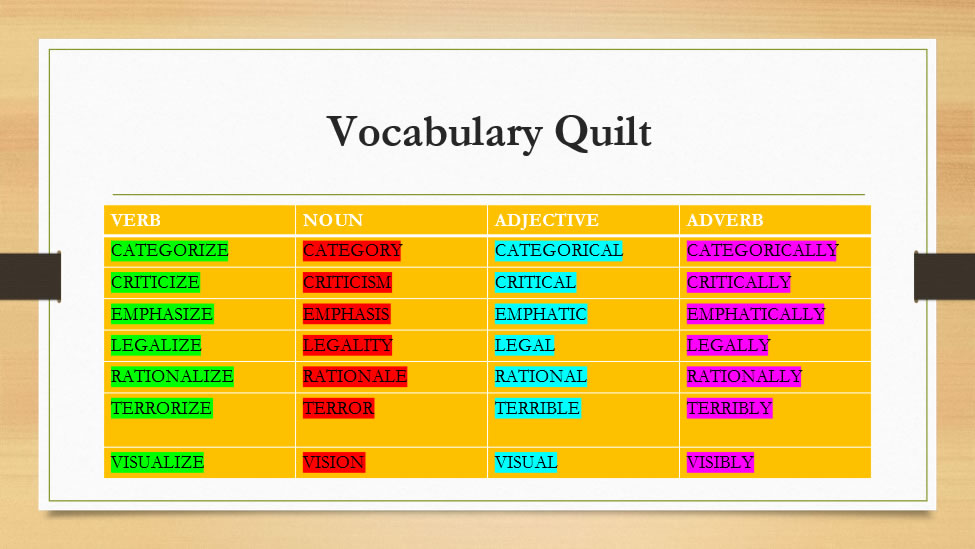|

One of the most formidable hurdles in learning any
language is vocabulary (Peregoy & Boyle 2017, p. 252). Simply stated,
learning English vocabulary can be complicated, owing to the complexity of the
English lexicon. Students of the language will notice words with overlapping
meanings, words combined with other words to form a single entity, words
defined by their relationship with other words, and words that sound the same
but have different meanings.
The purpose here is to present engaging vocabulary
activities through the implementation of metacognition: “the processes used to
plan, monitor, and assess one’s understanding and performance. Metacognition
includes a critical awareness of a) one’s thinking and learning and b) oneself
as a thinker and learner” (Chick, 2020).
 The
following activities for metacognitive growth aim to be accessible to all
English language classes. They can be reproduced with minimal preparation if
necessary, to meet the needs of educators with limited resources. These
activities are adaptable, modifiable, and can be used in various learning
environments. They are unique because they apply three types of metacognition
as a vehicle for vocabulary learning: The
following activities for metacognitive growth aim to be accessible to all
English language classes. They can be reproduced with minimal preparation if
necessary, to meet the needs of educators with limited resources. These
activities are adaptable, modifiable, and can be used in various learning
environments. They are unique because they apply three types of metacognition
as a vehicle for vocabulary learning:
-
Metacognitive
Knowledge: knowledge about how learning operates and how to
improve learning.
-
Metacognitive
Monitoring: judging whether you are approaching the correct
solution to the problem and assessing how well you understand what you are
reading.
-
Metacognitive
Control: deciding to use a new tactic to solve a difficult
problem; deciding to use a new approach for a difficult task.
(Dunlosky,
2009, p. 3)
1. Word of the Day
Poster Presentation
Steps
-
Depending on the objectives of your vocabulary lesson,
have students choose a word to present (a) or let them choose from a selection
(b):
-
Allowing students the freedom to choose any word, such
as one they saw in print (e.g., in a book, sign, label, pamphlet, poem) and want to
explore further can provide a motivating factor to the activity.
-
It
can be very effective to present a list of words within specific parameters,
such as words related to a particular unit, lesson, or topic.
Explain they
will describe, illustrate, and define their word on a poster in multiple ways:
synonyms, antonyms, word origin, number of syllables, collocations, and so on.
-
As students create their poster, they should ask
themselves these questions to bolster true understanding of the
vocabulary:
-
Do I understand this definition?
-
Will my classmates
understand this definition? If not, should I phrase it in a different way, so
it is clear to them?
-
Are these synonyms and
antonyms words I already know and understand?
-
Do
my classmates know the words I present as synonyms and antonyms?
-
Is
my illustration a true representation of this word?
-
Will my classmates
understand my illustration?
-
If
not, should I use multiple illustrations to help me and my classmates better
visualize and learn this word?
-
On
the day of the Word of the Day Poster presentation, the audience is encouraged
to guess the meaning, part of speech, or pronunciation of the word. Both
student presenter and audience monitor their understanding of the word and are
encouraged to ask questions to strengthen their understanding.
-
Once the poster is
complete, it is posted for all to see and revisit at the end of the week/month.
This activity can be done online as well as in the classroom.
Metacognitive
Benefits
Students
must decide how, why, and to what extent to present their chosen word. In other
words, they must determine the best ways to present the vocabulary word for
learning and retention. As students create their poster, they monitor and
assess. By asking themselves the list of questions, they judge their approach
and are encouraged to self-monitor.

By
approaching this activity metacognitively, students are in control of their own
learning and are more apt to discover how they and others learn vocabulary
best. These posters will aid their preparation for their vocabulary test and
assist in evaluating learning and planning for the future “word of the day”
posters.
2. Rating and Raising
Word Knowledge (Rate It)
Steps
-
Using a new word list, have students rate their
knowledge of the words according to the following rating system.
0 – This word is new to me; I have never seen
or heard this word before.
1 – This
word is not new to me; I have seen it or heard it, but I do not know what it
means.
2 – I think
I know the meaning of the word and will guess it.
3 – I can
explain the meaning of the word and use it in a sentence.
(Coxhead,
2014)
-
Once the students have
rated their words, have them to do the following:
-
For words identified as “3,” write the definition of the
word and a corresponding sentence.
-
For words identified as
“2,” write down what you think the meaning is. Make the following
guesses:
-
Write the part of speech.
-
Write prefixes, suffixes,
and the root of the word.
-
Write the context in which
the word is used (the words that are around this word and affect its
meaning).
-
Write the circumstance in
which the word is used (the register of the word).
-
For words identified as
“1,” answer as many of the questions as you can:
-
If I think I know this word, why do I think so?
-
Have I heard it?
-
When was the last time I
heard someone use this word?
-
Have I seen it?
-
Where was the last place I
saw this word?
-
Why don’t I know this word
well?
-
Why is it so puzzling to
me?
-
For words identified as
“0,” you can guess or leave alone.
-
When all of the students are
done deducing the meaning of these words, have them compare the definitions of
the words in small groups (two to four students).
-
After, bring students
together as one class and share the meanings of the words.
-
Verify if the 3 rating is
correct and have students read their sentences and explain how they know the
word.
-
If
the 3 rating is incorrect, ask the students the following questions:
-
Why did you think this word had that definition?
-
When do you think you heard
the word used before?
-
Where had you seen the word
before?
-
Ask the students who rated
the word with a 1–2 (and who guessed correctly) to explain the process they
used which led them to the correct definition.
-
Encourage students to
explain their guesses for words rated 1 and 2.
-
Conclude the activity by
asking students what they learned about vocabulary learning using the rating
system.
-
Encourage the students to
reuse the strategies they incorporated in discovering the meaning of their
words.
Metacognitive
Benefits
To
comprehend the meaning of their new vocabulary word list, students assessed
what they knew and did not know. For words rated 1 and 2, students were
obligated to use metacognition. They made guesses based on their prior
knowledge, analyzed the vocabulary words, and made logical deductions. These
deductions derived from their knowledge of word parts and word knowledge. Thus,
the correct meaning may have been reached as a result of the student’s
knowledge of the root, prefix, or suffix of the word; the word being a cognate
of their first language; or their ability to reconstruct the context and
register in which the word was seen or heard.
Students
glean the reward of metacognition by explaining their word learning process and
experiences. Through metacognition, they judge how they came to the correct or
incorrect solutions. They can then use the metacognitive monitoring learned in
this activity to tackle future encounters with new vocabulary.
3. Vocabulary
Quilt
Steps
-
Before class, create a blank vocabulary quilt and
accompanying vocabulary cards. The quilt is a colorful, blank chart presented
on a large poster. The chart should have four columns, each labeled for a
different part of speech (or word family); the number of rows depends on the
number of vocabulary words you wish to use in this activity. (See Figure 1.) The
vocabulary cards should be colorful cards that fit into the spaces on the
chart; there should be a corresponding card for each space on the chart.

Figure 1. Example blank vocabulary quilt using four parts of speech.
(Click here to enlarge.)
-
In
class, distribute the vocabulary cards to students and ask them to quietly
guess the part of speech of each card.
-
Present the vocabulary
quilt to students, and then place it on a table in the center of the room. Have
students gather around the table.
-
One at a time, students choose a word card and place it
in the column corresponding to the correct part of speech/word
family.
-
As
students place their cards on the table, they are encouraged to seek help from
each other and determine the best strategy for card placement. Encourage
students to talk to one another and strategize together how to complete the
vocabulary quilt.
-
Ask students if they see
any patterns being revealed in the vocabulary quilt chart.
-
Once all the cards are placed on the quilt, check for
correctness. See Figure 2 for an example of a completed quilt.

Figure 2. Example of completed vocabulary quilt. In this case, the parts of speech cards are all in the same color for easier recognition. The colors of the cards can be randomized so the completed quilt presents a mix of colors. (Click here to enlarge.)
-
Have students evaluate the
characteristics of each correct placement.
-
Have students judge what
they learned and how they learned it, and then have students identify the most
helpful strategies they employed in this activity.
Options for Online
Teaching
This
activity can be done virtually via Zoom. Email students their vocabulary cards
in advance and present the vocabulary quilt using PowerPoint or Google Slides.
When it is time for the students to place their cards on the quilt, have them
inform you where they would like to place their cards, and you can type their
words into their designated location. The whole class would assist in the
placement of the cards. All would assess if the cards were properly
placed.
Alternatively, you can use an
interactive whiteboard app, like Jamboard
or Seesaw, which
allows you to share your digital quilt with students and have them place cards
on their own, either in small groups or as a whole class.
Metacognitive
Benefits
In this
vocabulary quilt activity, students make deductions by checking for
similarities of words in the categories. They consult one another for
assistance and use strategies of elimination, agreement, and concession. In
utilizing metacognition in the creation of the vocabulary quilt, students
acquire knowledge about learning, assess how well they understand vocabulary,
judge whether or not they make correct decisions, and monitor their choices and
the choices of others.
Conclusion
The
vocabulary activities presented here have been used in intermediate-level
literacy courses, and the students who participated in these activities not
only enjoyed them but attested that they were memorable and helped them improve
their English vocabulary knowledge. I also noticed that these activities
created fun, interactive experiences that enhanced vocabulary learning and
activated metacognition.
References
Chick, N.
(2020). Metacognition. Vanderbilt University Center for
Teaching. https://cft.vanderbilt.edu/guides-sub-pages/metacognition/
Coxhead, A.
(2014). New ways in teaching vocabulary. TESOL
Press.
Dunlosky, J. (2009). Metacognition. SAGE.
Peregoy, S.
F., & Boyle, O. (2017). Reading, writing, and learning in
ESL: A resource book for teaching K-12 English learners.
Pearson.
Rita F. Naughton teaches as an assistant professor in the Intensive English, Undergraduate Bridge and Master TESOL Program at Southern New Hampshire University. Her scholarly interests include academic research writing, metacognitive learning strategies, ESL writing workshop programs, and assessment and evaluation practices, as well as incorporating learning games for motivation and success in the English language classroom. |